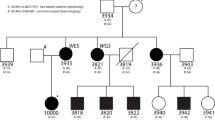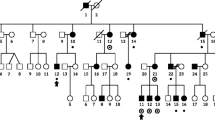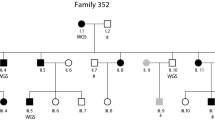Abstract
Developmental dyslexia, or reading disability, is a multigenic complex disease for which at least five loci, i.e. DYX1–3 and DYX5–6, have been clearly identified from the human genome. To date, DYX1C1 is the only dyslexia candidate gene cloned. We have previously reported linkage to 2p11 and 7q32 in 11 Finnish pedigrees. Here, we report the fine mapping of the approximately 40-cM linked region from chromosome 2 as we increased marker density to one per 1.8 cM. Linkage was supported with the highest NPL score of 3.0 (P=0.001) for marker D2S2216. Association analysis using the six pedigrees showing linkage pointed to marker D2S286/rs3220265 (P value <0.001) in the near vicinity of D2S2216. We went on to further characterise this ~15-cM candidate region (D2S2110-D2S2181) by adding six SNPs covering ~670 kb centred at D2S286/rs3220265. A haplotype pattern could no longer be observed in this region, which was therefore excluded from the candidate area. This also excluded the TACR1 (tachykinin receptor 1) gene, located at marker D2S286. The dyslexia candidate region on 2p11 is, therefore, now limited to the chromosomal area D2S2116-D2S2181, which is ~12 Mbp of human sequence and is at a distinct location from the previously reported DYX3 locus, raising the possibility of two distinct loci on chromosome 2p.



Similar content being viewed by others
References
Cardon LR, Smith SD, Fulker DW, Kimberling WJ, Pennington BF, DeFries JC (1994) Quantitative trait locus for reading disability on chromosome 6. Science 266:276–279
De Felipe C, Herrero JF, O’Brien JA, Palmer JA, Doyle CA, Smith AJ, Laird JM, Belmonte C, Cervero F, Hunt SP (1998) Altered nociception, analgesia and aggression in mice lacking the receptor for substance P. Nature 392:394–397
Derocq JM, Segui M, Blazy C, Emonds-Alt X, Le Fur G, Brelire JC, Casellas P (1996) Effect of substance P on cytokine production by human astrocytic cells and blood mononuclear cells: characterization of novel tachykinin receptor antagonists. FEBS Lett 399:321–325
Fagerheim T, Raeymaekers P, Tonnessen FE, Pedersen M, Tranebjaerg L, Lubs HA (1999) A new gene (DYX3) for dyslexia is located on chromosome 2. J Med Genet 36:664–669
Fisher SE, DeFries JC (2002) Developmental dyslexia: genetic dissection of a complex cognitive trait. Nat Rev Neurosci 3:767–780
Fisher SE, Francks C, Marlow AJ, MacPhie IL, Newbury DF, Cardon LR, Ishikawa-Brush Y, Richardson AJ, Talcott JB, Gayan J, Olson RK, Pennington BF, Smith SD, DeFries JC, Stein JF, Monaco AP (2002) Independent genome-wide scans identify a chromosome 18 quantitative-trait locus influencing dyslexia. Nat Genet 30:86–91
Francks C, Fisher SE, Olson RK, Pennington BF, Smith SD, DeFries JC, Monaco AP (2002) Fine mapping of the chromosome 2p12-16 dyslexia susceptibility locus: quantitative association analysis and positional candidate genes SEMA4F and OTX1. Psychiatr Genet 12:35–41
Gerard NP, Garraway LA, Eddy RL Jr, Shows TB, Iijima H, Paquet JL, Gerard C (1991) Human substance P receptor (NK-1): organization of the gene, chromosome localization, and functional expression of cDNA clones. Biochemistry 30:10640–10646
Grigorenko EL (2001) Developmental dyslexia: an update on genes, brains, and environments. J Child Psychol Psychiatry 42:91–125
Hopkins B, Powell SJ, Danks P, Briggs I, Graham A (1991) Isolation and characterisation of the human lung NK-1 receptor cDNA. Biochem Biophys Res Commun 180:1110–1117
Jurinke C, Van der Boom D, Cantor CR, Köster H (2002) Automated genotyping using DNA MassARRAY technology. Methods Mol Biol 187:179–192
Kaminen N, Hannula-Jouppi K, Kestilä M, Lahermo P, Muller K, Kaaranen M, Myllyluoma B, Voutilainen A, Lyytinen H, Nopola-Hemmi J, Kere J (2003) A genome scan for developmental dyslexia confirms linkage to chromosome 2p11 and suggests a new locus on 7q32. J Med Genet 40:340–345
Kong A, Gudbjartsson DF, Sainz J, Jonsdottir GM, Gudjonsson SA, Richardsson B, Sigurdardottir S, Barnard J, Hallbeck B, Masson G, Shlien A, Palsson ST, Frigge ML, Thorgeirsson TE, Gulcher JR, Stefansson K (2002) A high-resolution recombination map of the human genome. Nat Genet 31:241–247
Kramer MS, Cutler N, Feighner J, Shrivastava R, Carman J, Sramek JJ, Reines SA, Liu G, Snavely D, Wyatt-Knowles E, Hale JJ, Mills SG, MacCoss M, Swain CJ, Harrison T, Hill RG, Hefti F, Scolnick EM, Cascieri MA, Chicchi GG, Sadowski S, Williams AR, Hewson L, Smith D, Rupniak NM, et al (1998) Distinct mechanism for antidepressant activity by blockade of central substance P receptors. Science 281:1640–1645
Kruglyak L, Daly MJ, Reeve-Daly MP, Lander ES (1996) Parametric and nonparametric linkage analysis: a unified multipoint approach. Am J Hum Genet 58:1347–1363
Lahiri DK, Nurnberger JI (1991) A rapid non-enzymatic method for the preparation of HMW DNA from blood for RFLP studies. Nucleic Acids Res 19:5444
Nopola-Hemmi J, Myllyluoma B, Haltia T, Taipale M, Ollikainen V, Ahonen T, Voutilainen A, Kere J, Widen E (2001) A dominant gene for developmental dyslexia on chromosome 3. J Med Genet 38:658–664
O’Connell JR, Weeks DE (1998) PedCheck: a program for identification of genotype incompatibilities in linkage analysis. Am J Hum Genet 63:259–266
Petryshen TL, Kaplan BJ, Fu Liu M, de French NS, Tobias R, Hughes ML, Field LL (2001) Evidence for a susceptibility locus on chromosome 6q influencing phonological coding dyslexia. Am J Med Genet 105:507–517
Petryshen TL, Kaplan BJ, Hughes ML, Tzenova J, Field LL (2002) Supportive evidence for the DYX3 dyslexia susceptibility gene in Canadian families. J Med Genet 39:125–126
Povey S, Lovering R, Bruford E, Wright M, Lush M, Wain H (2001) The HUGO Gene Nomenclature Committee (HGNC). Hum Genet 109:678–680
Schulte-Korne G, Grimm T, Nothen MM, Muller-Myhsok B, Cichon S, Vogt IR, Propping P, Remschmidt H (1998) Evidence for linkage of spelling disability to chromosome 15. Am J Hum Genet 63:279–282
Taipale M, Kaminen N, Nopola-Hemmi J, Haltia T, Myllyluoma B, Lyytinen H, Muller K, Kaaranen M, Lindsberg PJ, Hannula-Jouppi K, Kere J (2003) A candidate gene for developmental dyslexia encodes a nuclear tetratricopeptide repeat domain protein dynamically regulated in brain. Proc Natl Acad Sci USA 100:11553–11558
Toivonen HT, Onkamo P, Vasko K, Ollikainen V, Sevon P, Mannila H, Herr M, Kere J (2000) Data mining applied to linkage disequilibrium mapping. Am J Hum Genet 67:133–145
Acknowledgements
We thank Dr. Cecilia Lindgren for her valuable comments on the manuscript and for supervising the SNP genotyping work at the Mutation Analysis Facility (MAF), Clinical Research Center, Huddinge Hospital, Sweden. This work was supported by the Sigrid Jusélius Foundation, the Academy of Finland and the Swedish Medical Research Council (“Vetenskapsrådet”).
Author information
Authors and Affiliations
Corresponding author
Additional information
H. Anthoni and P. Onkamo contributed equally to this work
Rights and permissions
About this article
Cite this article
Peyrard-Janvid, M., Anthoni, H., Onkamo, P. et al. Fine mapping of the 2p11 dyslexia locus and exclusion of TACR1 as a candidate gene. Hum Genet 114, 510–516 (2004). https://doi.org/10.1007/s00439-004-1103-0
Received:
Accepted:
Published:
Issue Date:
DOI: https://doi.org/10.1007/s00439-004-1103-0




